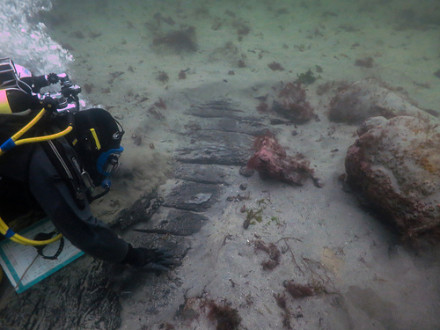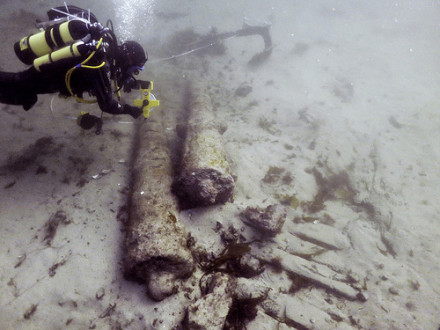History
Discovery
The Drumbeg wreck-site was discovered by local scallop divers around 1994 in Eddrachillis Bay, near the village of Drumbeg in the north-west Scottish Highlands. For several years they carried out preliminary investigations by themselves before bringing their discovery to the attention of Historic Scotland in 2011. On behalf of Historic Scotland a field evaluation was undertaken by Wessex Archaeology in 2012.
Field research
Although research into the Drumbeg wreck have to date been limited in scope, a wide range of material has already been identified at the site. The main site, lying at a depth of approximately 9-12 meters, consists of three heavily encrusted cast iron guns of possible Swedish design and intended for use by the Dutch, lying over a section of wooden hull. This structure, comprising frames and possible ceiling planking over an estimated length of 15 meters, is partially buried in sediment and appears well preserved. Small artefacts identified on the site include a deadeye rigging block, a number of red and yellow bricks and cannonballs of various sizes.

An important clue to the dating and identity of the wreck was found in the form of a painted tile fragment. The Delftware tile depicts a three-masted ship flying the Dutch flag and has been dated by typology to the period 1650 - 1750. As such, the tile suggests that the wrecking of the ship took place after 1650. However, the actual date for the wrecking may be significantly later given the long time depth of the Delft tile designs and their variable use on ships, such as ballast, cargo, or as personal possessions.

Identification
Although searches within documentary records have not yet identified with any degree of certainty the name of the ship, one candidate seems to stand out. The probable 17th/18th century Northern European origin of the wreck corresponds most directly to the privately owned merchantman Gekroonde Raaf ('Crowned Raven'), which was lost on the Assynt coast - the area in which Drumbeg is situated - sometime around 1691.
The wrecking of the Gekroonde Raaf is described by the skipper Tiert Jelles in a petition to the Privy Council of Scotland. Loaded with several sorts of timber such as masts, hemp and lint, the ship was on its way from Riga to Portugal, when it struck rocks a the Assynt coast. The ship quickly began to fill up with water, but, according to the skipper, by the providence of Almighty God the crew safely reached the shore. However, soon after their arrival, local country people flocked to the beach to plunder the ship, breaking it to pieces. By means of the petition to the Privy Council, Jelles hoped to be allowed to retrieve his goods.
Description
The finds (the tile and the cannons) point to a Dutch ship from the lat 17th-early 18th century. If a Dutch ship foundered here, it is quite likely that this happened during a period of war with England or France, since ships used to take this northern route to avoid being taken in the Channel.
Status
Only a handful of underwater archaeological sites around Scotland's waters that are over 200 years old have been discovered. The Scottish Cabinet Secretary for Culture and External Affairs was therefore quick to designate the well preserved Drumbeg Wreck site as the first of Scotland's Historic Marine Protected Areas. The institutions involved in the research into the wreck are Historic Scotland and Wessex Archaeology.

Future assessment of the wreck is expected to yield an even wider cross section of material present at the site, given the significant potential for preservation within seabed sediments across the area.
In 2016, a 3-D model of the site was made (see references).
References
- Wessex archaeology.
Drumbeg wreck. - Monument MHG56884.
- John McCarthy.
Unknown wreck Drumbeg, Highlands. - Steven McKenzie.
3D prints of shipwrecks off Drumbeg and Folkestone.